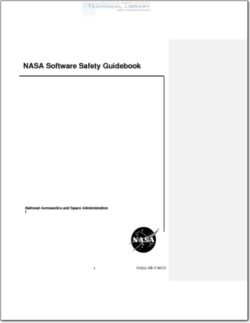NASA SOFTWARE SAFETY GUIDEBOOK

- Version
- 258 Downloads
- 4.74 MB File Size
- 1 File Count
- May 19, 2016 Create Date
- May 19, 2016 Last Updated
NASA SOFTWARE SAFETY GUIDEBOOK

1.1 Scope
The focus of this document is on analysis and development of safety critical software, including
firmware (e.g. software residing in non-volatile memory, such as ROM, EPROM, or EEPROM)
and programmable logic.
This Guidebook provides information on development activities and analyses used in the
creation and assurance of safety critical software. Resource data required for each task,
methodologies and tools for performing the task, and the output products are detailed. It also
describes how to address software safety in the overall software development, management, and
risk management activities.
xii NASA—GB—l740.l3
This Guidebook goes on to describe techniques and procedures. Some techniques are well
established and are illustrated in detail (or good reference sources are provided). Other
techniques or analyses are new, and not much information is available. The Guidebook attempts
to give a flavor of the technique or procedure as well as pointing to sources of more information.
To make the guidebook more practical, it contains analysis examples and possible pitfalls and
problems that may be encountered during the analysis process. It is a synergistic collection of
techniques either already in use throughout NASA and industry, or which have potential for use.
Opinions differ widely concerning the validity of the various techniques, and this Guidebook
attempts to present these opinions, without prejudging their validity. In most cases there are few
or no “metrics” to quantitatively evaluate or compare the techniques. Moreover, this Guidebook
is meant not only to provide possible techniques and analyses, but to open the reader to how to
think about software from a safety perspective. It is important to observe software development
with a “safety eye”. This Guidebook points out things to look for (and look out for) in the
development of safety critical software. Development approaches, safety analyses, and testing
methodologies that lead to improved safety in the software product are included.
Numerous existing documents provide details on various analysis techniques. If a technique is
well described elsewhere, references are provided. If a NASA standard or guideline exists which
defines the format and/or content of a specific document, it is referenced and the user should
follow the instructions of that document.
In addition to the existing techniques in the literature, some practical methods are presented
which have been developed and used successfully at the system level for top-down software
hazards analyses. Their approach is similar to NSTS 13830 Implementation Procedure for
NASA Payload System Safety Requirements [2].
There are many different analysis techniques described in the open literature that are brought
together, evaluated, and compared. This guidebook addresses the value added versus cost of
each technique with respect to the overall software development and assurance goals.
The reader is expected to have some familiarity with the NASA methodologies for system safety
analysis and/or software development. However, no experience with either is assumed or
required. Readers completely unfamiliar with NASA methodologies for software development
and system safety may have difficulty with some portions of this guidebook. Acronyms and
definitions of terminology used in this guidebook are contained in Appendix—A.
| File | Action |
|---|---|
| NASA SOFTWARE SAFETY GUIDEBOOK.pdf | Download |

Comment On This Post